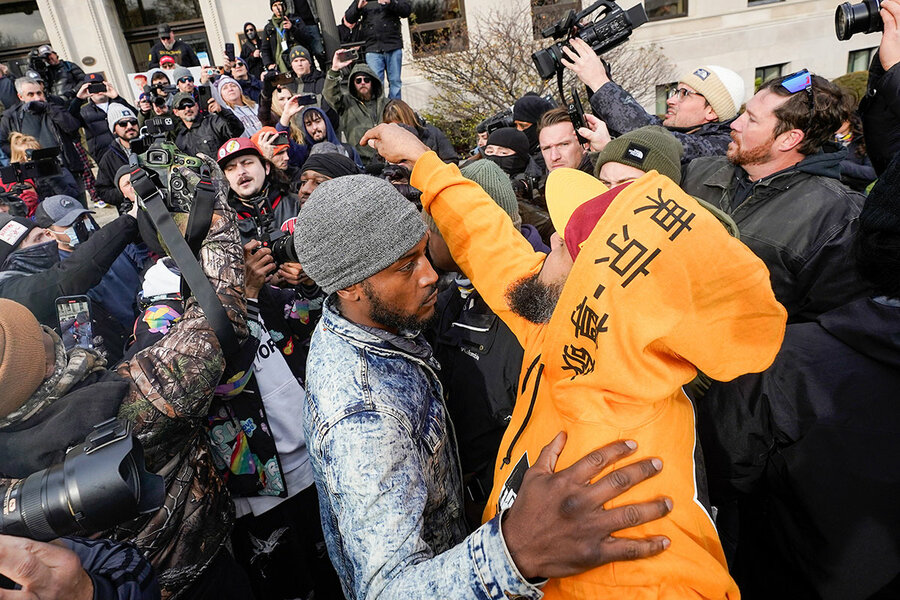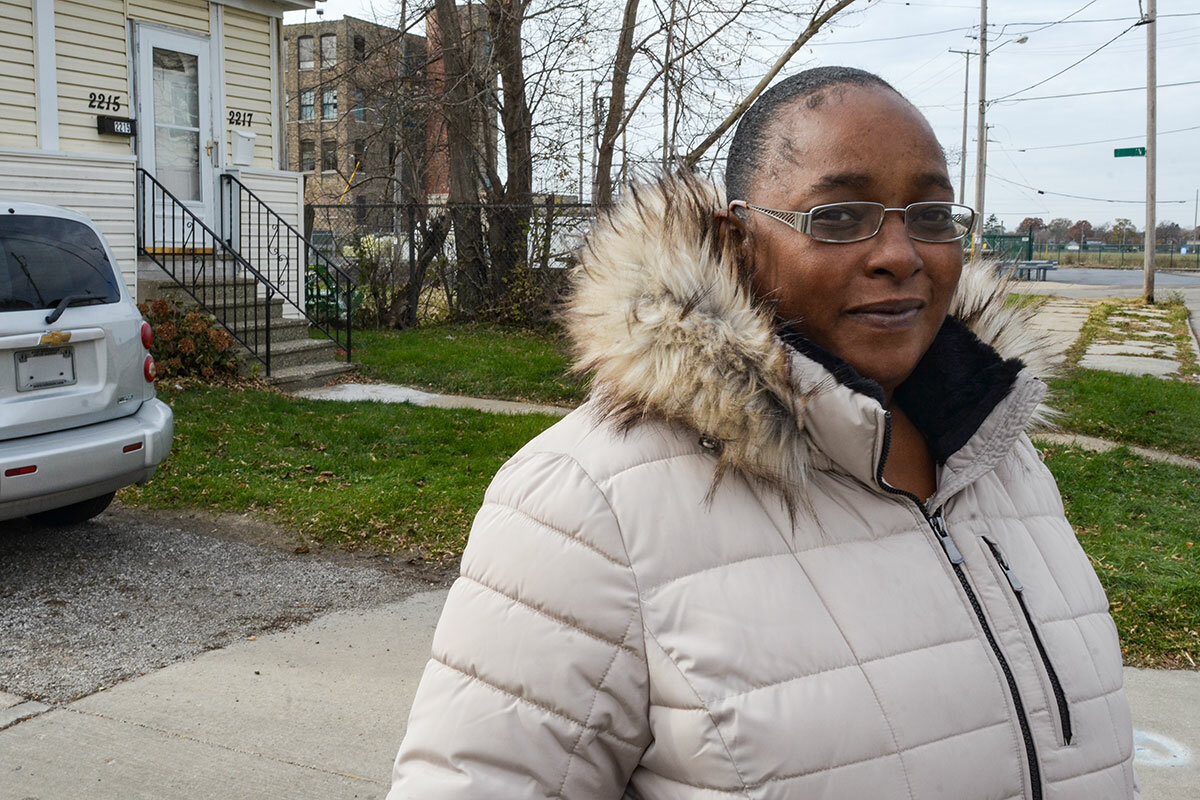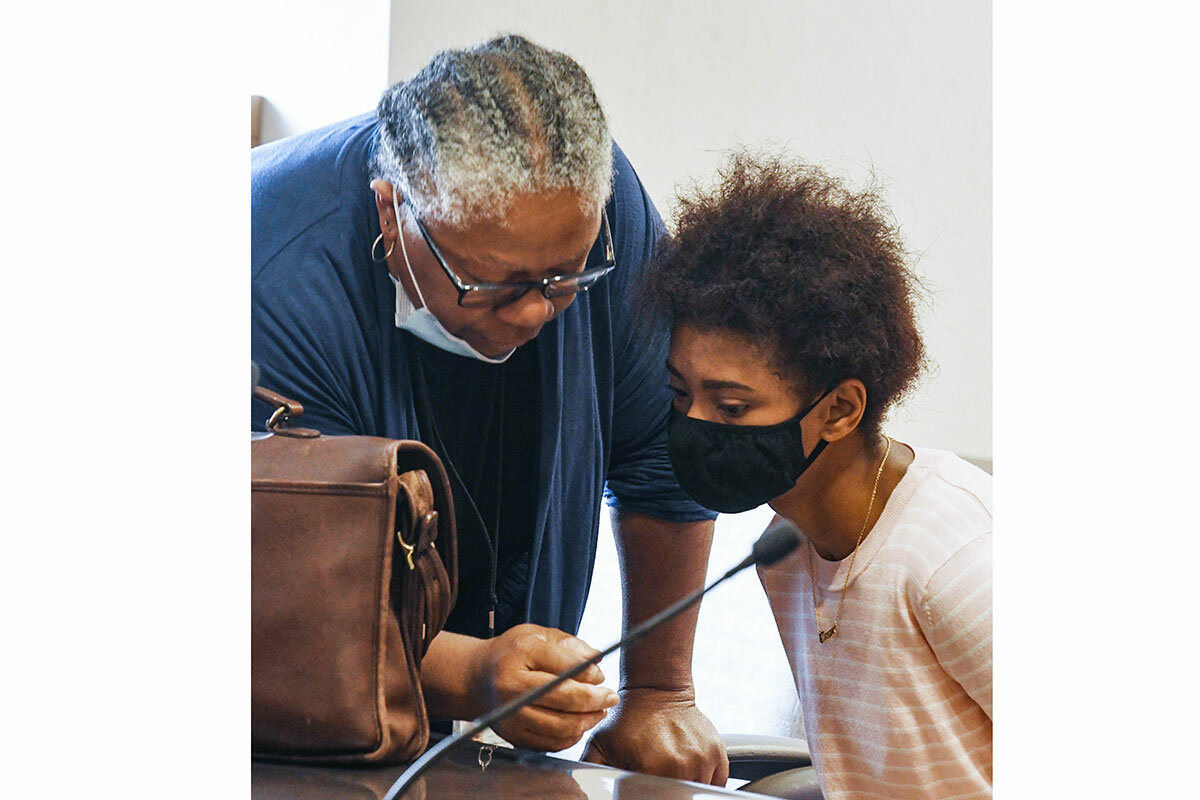After Rittenhouse: What an era of armed protest means for America
Loading...
| Kenosha, Wis.
After the acquittal on Friday of Kyle Rittenhouse for killing two protesters and injuring another during social upheaval in Kenosha, Wisconsin, last year, folks once again took to the streets here in Kenosha, but the numbers were far fewer.
One group of marchers peacefully followed Mr. Rittenhouse’s footsteps from the night of the killing, as laid out in a map shown to the jury.
While the Rittenhouse verdict upheld a heavily armed teenager’s right to kill those his presence provoked to violence, it set no legal precedent.
But such verdicts “do help set a cultural norm,” says Keith Findley, a law professor at the University of Wisconsin-Madison.
The Rev. Jonathan Barker, pastor at Grace Lutheran Church in Kenosha, has noticed more people carrying guns at protests. “Everybody’s armed up,” he says. On Sunday, in response to the uptick in arms, one protest leader introduced a new set of hand signals to guide protesters: go, stop, and hit the ground.
Across the country, there’s a surge in gun purchases, including by nontraditional groups, as people sense a rise in vigilantism. But the idea of self-defense is also evolving. A few recent verdicts suggest that Black defendants are winning self-defense claims that historically would have turned against them.
“Whose protest is it ... [and] what is the relationship between guns and protest? We are now having that conversation in a more explicit way,” says University of Arizona sociologist Jennifer Carlson.
Who’s protecting whom?
New sets of Americans staking their own protection and defense claims are seen by some, like Mr. Barker, as a sobering, potentially dangerous development. Studies have found that the presence of firearms makes violence at protests more likely.
Given that, history suggests armed Black protesters should be especially concerned. “Homicides with a white perpetrator and a black victim are ten times more likely to be ruled justified than cases with a black perpetrator and a white victim,” the Urban Institute found.
“We also know from social psychology that people of color carrying guns are more likely to be seen as a threat, regardless of the legal status of their guns,” says Dr. Carlson, who is also the author of “Citizen-Protectors.”
But changing protest dynamics could push the country in a new direction. Following Mr. Rittenhouse’s footsteps – both literally and philosophically – is a reminder to at least some Americans that their problems may be less about “the other side” and more about fundamental societal and institutional injustices that affect a broad range of Americans in distinct, but sometimes similar, ways.
“Kyle Rittenhouse and Black Lives Matter have one important thing in common, and it’s something that could be harnessed for effective political change: They both feel like they have been unjustly treated by the criminal justice system,” says Eugene Volokh, a First Amendment scholar at the UCLA School of Law. “People may [also] rightly ask, ‘If police aren’t going to protect me, who is going to protect me?’”
Kenosha finds itself at the heart of these emerging dynamics.
Once a fishing village on the shores of Lake Michigan – it was first known as Kenozia, or “place of the pike” – the city of 100,000 is today home to the underwear knitter Jockey and massive Amazon warehouses. Median earnings here lag about $10,000 behind national averages. Two-thirds of residents are white. Some 18% of its residents – most of them white – live in poverty,
“The community will always be divided. But we have to live together,” says Anna Moldenhauer, a vendor at the Kenosha Public Market.
Shifting views of self-defense
The mostly white Rittenhouse jury heard weeks of testimony and complicated legal theories. But it is the jury’s collective wisdom – or, to some, recklessness – that is resonating across the country now.
“What is reasonable is defined by individual juries, who bring their lived experiences, values, and cultural norms to the task,” Mr. Findley, the Madison law professor, writes in an email.
For some, the verdict affirms and expands an already grave concern among people of color. “We have to live in fear not only of the police, but of white supremacists as well. It just gives people a sense of entitlement to do whatever they want to do,” says Elizabeth Webb, a social justice activist in Kenosha.
The Rittenhouse jury verdict was also a reminder for some of a long history in the United States of differing abilities to claim self-defense.
“If we decide to take matters into our own hands, Black and brown people, we know we’re going to be prosecuted to the full sense of the law,” says Ms. Webb.
Yet juries have been more nuanced of late.
“Stand your ground” laws came to the fore in Sanford, Florida, in the George Zimmerman trial in 2013. The argument that his victim, Trayvon Martin, fought back in self-defense against an armed adult pursuer didn’t prevail. The jury instead bought Mr. Zimmerman’s claim.
But a few years later, a different jury took another view of a similar case. Michael Drejka, a white man, killed a Black man named Markeis McGlockton after being pushed to the ground. A Clearwater, Florida, jury found Mr. Drejka’s purported fear of serious bodily injury unreasonable. He was sentenced to 20 years in prison.
And on the same day the Rittenhouse verdict was announced, a Vero Beach, Florida, jury acquitted a Black man named Andrew Coffee on murder charges. In 2017, Mr. Coffee, a felon, had opened fire on sheriff’s deputies conducting a drug raid on his house. Authorities charged Mr. Coffee with the death of his girlfriend, who was hit 10 times when deputies returned fire. Mr. Coffee claimed self-defense, thinking he was being burgled. The jury agreed.
Looking ahead, Chrystul Kizer, a young Black Kenoshan, has been allowed by an appeals court to raise a self-defense claim in her upcoming murder trial for allegedly killing a white man in 2018. The claim is based on a new Wisconsin law aimed at protecting those being sex-trafficked.
What has hampered self-defense claims by people of color in the past are prejudices in some cases baked into otherwise neutral-seeming law, says Harvard historian Caroline Light.
In such cases, she says, minority “victims who use lethal self-defense against abusers [watch as] their vulnerability gets carved out of the evidence that is presented.”
Ms. Kizer’s trial will test that pattern.
The right to protest – armed
Meanwhile, some Black Americans are experimenting with exercising constitutional rights that not long ago seemed out of reach.
In Kenosha last weekend, a Black father-daughter duo carrying military-style rifles provided security for social justice protesters. And as a case in Brunswick, Georgia, wound down against the three men who killed unarmed jogger Ahmaud Arbery, armed Black militia members took up guard outside the courthouse. The judge denied a defense request for a mistrial.
Not long after the Rittenhouse verdict, as people milled about Kenosha, three young white men stood next to an American flag hanging from a platform. They said they were there to protect the flag. A construction worker who gave his name only as Tony said he agreed with the verdict.
“I do think it was self-defense,” he said of Mr. Rittenhouse.
But he also listened sympathetically to the arguments of Black activists around him.
“If they’re working toward equality, I think it’s good,” he told the Monitor. “It’s something I have to keep my eyes open for.”
Richard Mertens reported from Kenosha. Patrik Jonsson reported from Tybee Island, Georgia.







